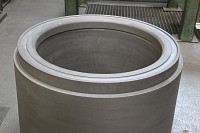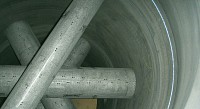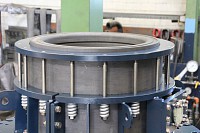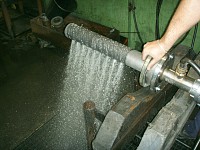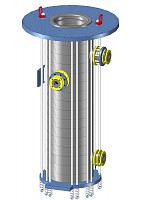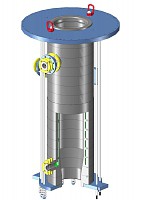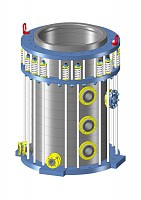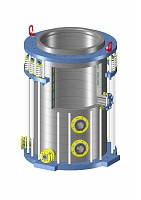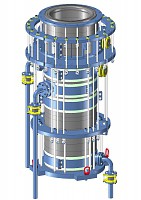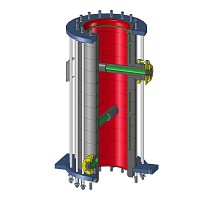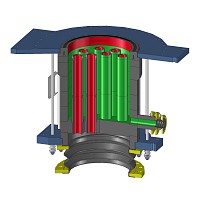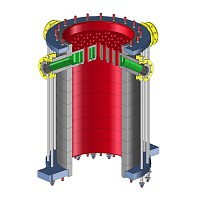Graphite quenches
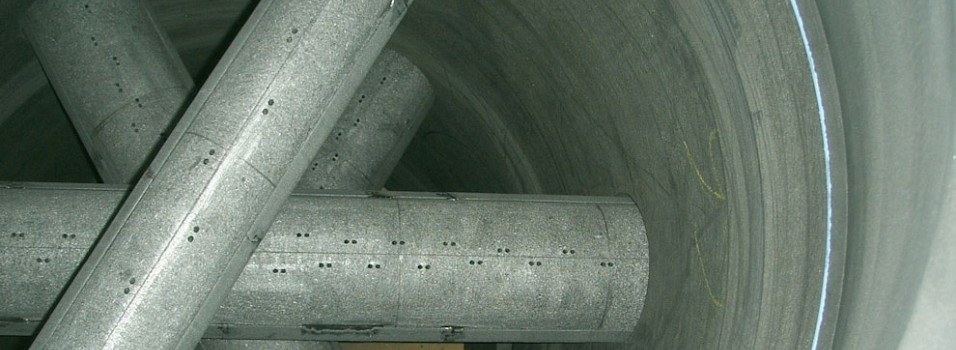
Quenches are used in various industries to instantaneously cool down hot gases coming from kilns, ovens, incinerators, and other flue gas sources. Graphite quenches are adapted to the rapid cooling of ultra-corrosive hot gases (up to 1300°C inlet temperature) and prevent the re-synthesis of dioxins and furans. Quenches are gas liquid contactors used to achieve mass and heat transfer between a continuous gas phase that might contain pollutants or/and dispersed solid particles and a dispersed liquid phase. GAB Neumann offer spray, pipe, or Venturi graphite quenches.
Snapshots
Upper section of a GAB Neumann graphite quench
Thanks to an internal annular groove, the upper part of GAB Neumann's graphite quenches is permanently cooled. Below the connecting flange of the flue gas pipe, the inner wall is additionally wet by an overflow. The quench wall is therefore cooled from the inside and protected on the gas side with a falling liquid film in addition.
Graphite spray quench
View inside a graphite spray quench
Upper section of a GAB Neumann graphite quench
Thanks to an internal annular groove, the upper part of GAB Neumann's graphite quenches is permanently cooled. Below the connecting flange of the flue gas pipe, the inner wall is additionally wet by an overflow. The quench wall is therefore cooled from the inside and protected on the gas side with a falling liquid film in addition.
Graphite lance with spraying nozzles
Testing of a graphite lance with spraying nozzles at nominal flowrate
3D Renderings
Small annular groove quench
GAB Neumann's annular groove quenches can be customized to best meet specific requirements.
Cross section of a small annular groove quench
GAB Neumann's annular groove quenches are water cooled thus guarantying a low wall temperature and therefore ensuring the equipment reliability and long lifetime.
Large annular groove quench
GAB Neumann's annular groove quenches can be customized to best meet specific requirements.
Cross section of a large annular groove quench
GAB Neumann's annular groove quenches are water cooled thus guarantying a low wall temperature and therefore ensuring the equipment reliability and long lifetime.
Graphite spray quench in its structure
GAB Neumann’s spray quench fully integrated in its steel structure.
Graphite spray quench
GAB Neumann’s spray quenches’ straight forward design ensures their reliability, flexibility, and long-term performance. The risk of plugging is almost inexistent.
Graphite pipe quench
GAB Neumann’s pipe quenches have large tube diameters in order to limit the risk of plugging.
Graphite Venturi quench
GAB Neumann’s Ventury quenches can be operated with high dust loads.
Materials:
- Impervious graphite: GAB GPX1, GPX1T or GPX2
- Pressure plates and flanges: carbon steel or stainless steel
- Tie rods, nuts, bolts, washers, springs: stainless steel
Design:
- Modular design: diameter, height, number of lances and spray nozzles can be adjusted.
- Maximum diameter: 900 mm
- Impervious graphite sections discs with straight flow channels on process side and annular grooves on service side.
- Graphite nozzles on product and utility sides
- Thermal expansion compensation ensured by tie rods and helical springs
- Carbon-fiber reinforcement (optional)
Key Features:
- Design pressure: -1 barg (full vacuum) to +3 barg (45 psig)
- Design temperature: -60 to +200°C (-76 to 392°F)
- Hot exhaust gases up to 1300°C inlet temperature
- Design: according to European Pressure Equipment Directive 2014/68/EU (PED) or ASME Code
Key Benefits:
- Outstanding corrosion resistance
- Instantaneous cooling
- Huge liquid-gas interfacial area
- Perfectly adapted liquid distribution design
- Efficient cooling of the quench walls even in the top section
- Low pressure drops
- Low water consumption compared to other designs and materials
- Low total cost of ownership compared to other designs and materials
- Impregnation before machining ensures resin free surfaces
- High operational safety
- Sturdy and modular design
- Short lead time
- Long lifetime
Optional features:
- Carbon fiber reinforcement
Main applications:
- Instantaneous cooling of flue gases coming from kilns, ovens, or incinerators
- Quenching of hot exhaust gases up to 1400°C inlet temperature
- Air pollution control
Technical documentation
Quenches
Spray quenches
A spray quench consists of an empty cylindrical vessel and nozzles that spray liquid into the vessel. Many nozzles are placed across the vessel at different heights to spray all of the gas as it moves through the vessel. The reason for using many nozzles is to maximize the number of fine droplets impacting the pollutant particles and to provide a large surface area for absorbing gas. Theoretically, the smaller the droplets formed, the higher the collection efficiency achieved for both gaseous and particulate pollutants. However, the liquid droplets must be large enough to not be carried out of the quench by the gas stream. Therefore, spray quenches nozzles produce droplets that are usually 100 to 500 µm in diameter. Although small in size, these droplets are large compared to those created in Venturi quenches that are 10 to 50 µm in size. The gas velocity is kept low to prevent excess droplets from being carried out of the quench.
Pipe quenches
A pipe quench consists of a cylindrical vessel containing tubes. The quencher liquid and the gas flow through the inlet crowns. Due to the reduced cross section, the velocity inside the tubes increases significantly thus creating high turbulence and intimate mixing. The direct contact between the gas and the liquid ensures instantaneous gas cooling. Pipe quenches should be preferred only when the gas and the liquid flowrates are rather stable and when the dusts load is low.
Venturi quenches
In a Venturi quench the energy from the inlet gas stream is effectively used to atomize the liquid being used to cool down the gas stream. A Venturi quench consists of three sections namely a converging section, a throat section, and a diverging section. The inlet gas stream enters the converging section and, as the area decreases, gas velocity increases. Liquid is introduced either at the throat or at the converging section. The inlet gas, forced to move at high velocities in the small throat section, shears the liquid from its walls, producing a high number of very tiny droplets. Particle and gas removal occur in the diverging section as the inlet gas stream mixes with the fog of tiny liquid droplets. The inlet stream then exits through the diverging section, where it is forced to slow down. Venturi quenches can be used to collect both particulate and gaseous pollutants, but they are more effective in removing particles than gaseous pollutants.
Venturi quenches efficiently cool down gases even those containing high amounts of dusts. They are fairly compact. Their spray nozzles lay outside of the gas flow thus ensuring a high operational safety.
GAB Neumann’s graphite quenches - Q series
GAB Neumann’s graphite quenches are vertically mounted. They primarily consist in a graphite column section fitted with spray lances (spray quench), vertical pipes (pipe quench), or a liquid distribution plate (Venturi quench).
Spray quenches
GAB Neumann’s graphite spray quenches consist in an impervious graphite column with cooled down walls fitted with non-impervious graphite lances with multiple spray nozzles generating extremely fine droplets. Thanks to their simple design they are very flexible and versatile pieces of process equipment with a high turndown ratio. They can accept high flowrate and temperature fluctuations. The equipment can be operated with high dust loads since the large aperture eliminates the risk of plugging.
Pipe quenches
GAB Neumann’s pipe graphite quenches consist in a series of graphite pipes going through a perforated plate. The quencher liquid and the gas flow through the inlet crowns at high velocities. High turbulence and direct contact between gas and liquid ensures instantaneous gas cooling. They have a rather narrow turn down ratio. The piece of equipment can be operated with reasonable dust load since large holes limit the risk of plugging.
Venturi quenches
Our Venturi quenches include a liquid distribution plate in their upper section, a throat section to accelerate the gas flow, a spray section right under the distribution plate followed by an abortion section with instantaneous cooling. They have a low turn down ratio but the piece of equipment can be operated with high dust loads.
Safety, reliability, and performance on the long-term are our primary considerations when we size, design and manufacture our graphite quenches.
Our extended graphite quenches portfolio enables us to provide particularly adapted solutions to any ultra-corrosive gas quenching application. All our graphite quench designs are modular to best fit with individual process specification. The diameter, height, type, number of spaying nozzles or tubes can be adapted to best meet the flowrates, velocities, pressure drops, and cooling requirements.
All our graphite annular groove quenches are machined after phenolic resin impregnation thus guarantying surfaces that are totally free of resin and ensuring therefore the highest possible heat transfer rate.
Industrial processes:
- Pollution control
- Thermal oxidation of halogenated solvents
- Crop protection
- Fumed silica
- Silicones
- Titanium dioxide
- Fine chemicals
- Active pharmaceutical ingredients
- Epichlorohydrin
- Vinyl chloride monomer
- Fire retardants
- Flavors and fragrances
- Vitamins
- Isocyanates
- Polycarbonate
- Coagulants
- Treatment, purification and concentration of spent acids
- and many more…
GAB Neumann GmbH
Alemannenstrasse 29
79689 Maulburg
Germany
GAB Neumann GmbH | Alemannenstrasse 29 | D-79689 Maulburg | Phone +49 (7622) 6751 0 | Fax +49 (7622) 6751 20 | E-Mail info@gab-neumann.de | www.gab-neumann.com


